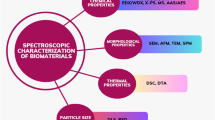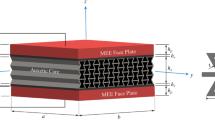Abstract
Nanoindentation methods are well suited for probing the mechanical properties of a heterogeneous surface, since the probe size and contact volumes are small and localized. However, the nanoindentation method may introduce errors in the computed mechanical properties when indenting near the interface between two materials having significantly different mechanical properties. Here we examine the case where a soft material is loaded in close proximity to an interface of higher modulus, such as the case when indenting bone near a metallic implant. The results are derived from both an approximate analytical quarter space solution and a finite element model, and used to estimate the error in indentation-determined elastic modulus as a function of the distance from the apex of contact to the dissimilar interface, for both Berkovich and spherical indenter geometries. Sample data reveal the potential errors in mechanical property determination that can occur when indenting near an interface having higher stiffness, or when characterizing strongly heterogeneous materials. The results suggest that caution should be used when interpreting results in the near-interfacial region.
Similar content being viewed by others
References
R.B. King: Elastic analysis of some punch problems for a layered medium. Int. J. Solids Struct. 23, 1657 (1987)
W.C. Oliver and G.M. Pharr: An improved technique for determining hardness and elastic modulus using load and displacement sensing indentation experiments. J. Mater. Res. 7, 1564 (1992).
J.S. Field and M.V. Swain: A simple predictive model for spherical indentation. J. Mater. Res. 8, 297 (1993).
S.V. Hainsworth, H.W. Chandler, and T.F. Page: Analysis of nanoindentation load displacement loading curves. J. Mater. Res. 11, 1987 (1996).
Y.T. Cheng and C.M. Cheng: What is indentation hardness? Surf. Coat. Technol. 417, 133 (2000).
S.G. Lewis, J. Beumer, G.R. Perri, and W.P. Hornburg: Single tooth implant supported restorations. Int. J. Oral Maxil. Imp. 3, 25 (1988).
T. Jemt: Modified single and short-span restorations supported by osseointegrated fixtures in the partially edentulous jaw. J. Prosthet. Dent. 55, 243 (1986).
P.T. Branemark, R. Adell, T. Albrektsson, U. Lekholm, S. Lundkvist, and B. Rockier: Osseointegrated titanium fixtures in the treatment of edentulousness. Biomaterials 4, 25 (1983).
M.C. Chang, C.C. Ko, C.C. Liu, W.H. Douglas, R. DeLong, W-J. Seong, J. Hodges, and K-N. An: Elasticity of alveolar bone near dental implant-bone interfaces after one month’s healing. J. Biomech. 36, 1209 (2003).
P.A. Clark, A.M. Clark, A. Rodriguez, M.A. Hussain, and J.J. Mao: Nanoscale characterization of bone-implant interface and biome-chanical modulation of bone ingrowth. Mater. Sci. Ens.. C 27, 382 (2007).
H. Graf: Occlusal forces during function, in Proceedings of Symposium on Occlusion: Research on Form and Function, edited by A. Rowe (University of Michigan School of Dentistry, Ann Arbor, MI, 1975), p. 90.
H.Y. Chou, J.J. Jagodnik, and S. Muftu: Predictions of bone remodeling around dental implant systems. J. Biomech. 41, 1365 (2008).
S.C. Cowin: Bone stress adaptation models. J. Biomech. Ens. 115, 528 (1993).
J.E. Jakes, C.R. Frihart, J.F. Beecher, R.J. Moon, and D.S. Stone: Experimental method to account for structural compliance in nanoindentation measurements. J. Mater. Res. 23, 1113 (2008).
Ya.S. Uflyand: Second basic problem of elasticity for a wedge. Trudy Leningr. Politekh. In-ta. 210, 87 (1960).
Ya.S. Uflyand: Some spatial elasticity problems for a wedge, in Continuum Mechanics and Related Problems of Analysis (Nauka, Moscow, 1972), p. 549.
J. Shim, H. Nakamura, and T. Ogawa: An understanding of the mechanism that promotes adhesion between roughened titanium implants and mineralized tissue. J. Biomech. Ens. 131, 054503 (2009).
G.Ya. Popov: An exact solution of the mixed elasticity problem in a quarter-space. Mech. Solids 38, 23 (2003).
H. Hertz: On the contact of elastic solids. J. Reine Angew. Math 92, 156 (1881).
A. Fischer-Cripps: Nanoindentation (Springer, New York, 2002).
G.M. Pharr, W.C. Oliver, and F.R. Brotzen: On the generality of the relationship among contact stiffness, contact area, and the elastic modulus during indentation. J. Mater. Res. 7, 613 (1992).
A.E.H. Love: Boussinesq’s problem for a rigid cone. O. J. Math. 10, 161 (1939)
J. Zhang, G.L. Niebur, and T.C. Ovaert: Mechanical property determination of bone through nano- and micro-indentation testing and finite element simulation. J. Biomech. 41, 267 (2008).
Author information
Authors and Affiliations
Corresponding author
Rights and permissions
About this article
Cite this article
Zhao, Y., Ovaert, T.C. Error estimation of nanoindentation mechanical properties near a dissimilar interface via finite element analysis and analytical solution methods. Journal of Materials Research 25, 2308–2316 (2010). https://doi.org/10.1557/jmr.2010.0295
Received:
Accepted:
Published:
Issue Date:
DOI: https://doi.org/10.1557/jmr.2010.0295




